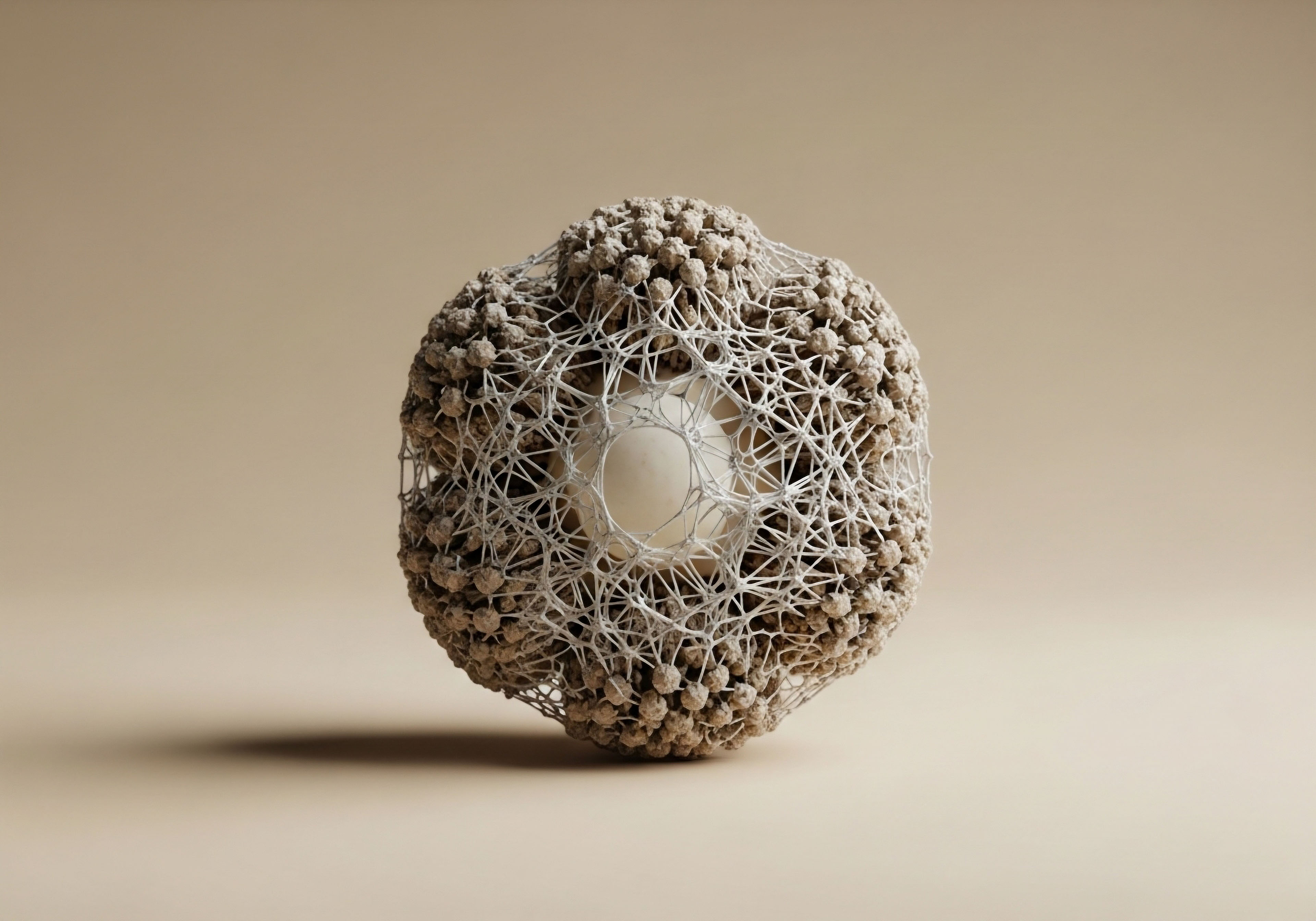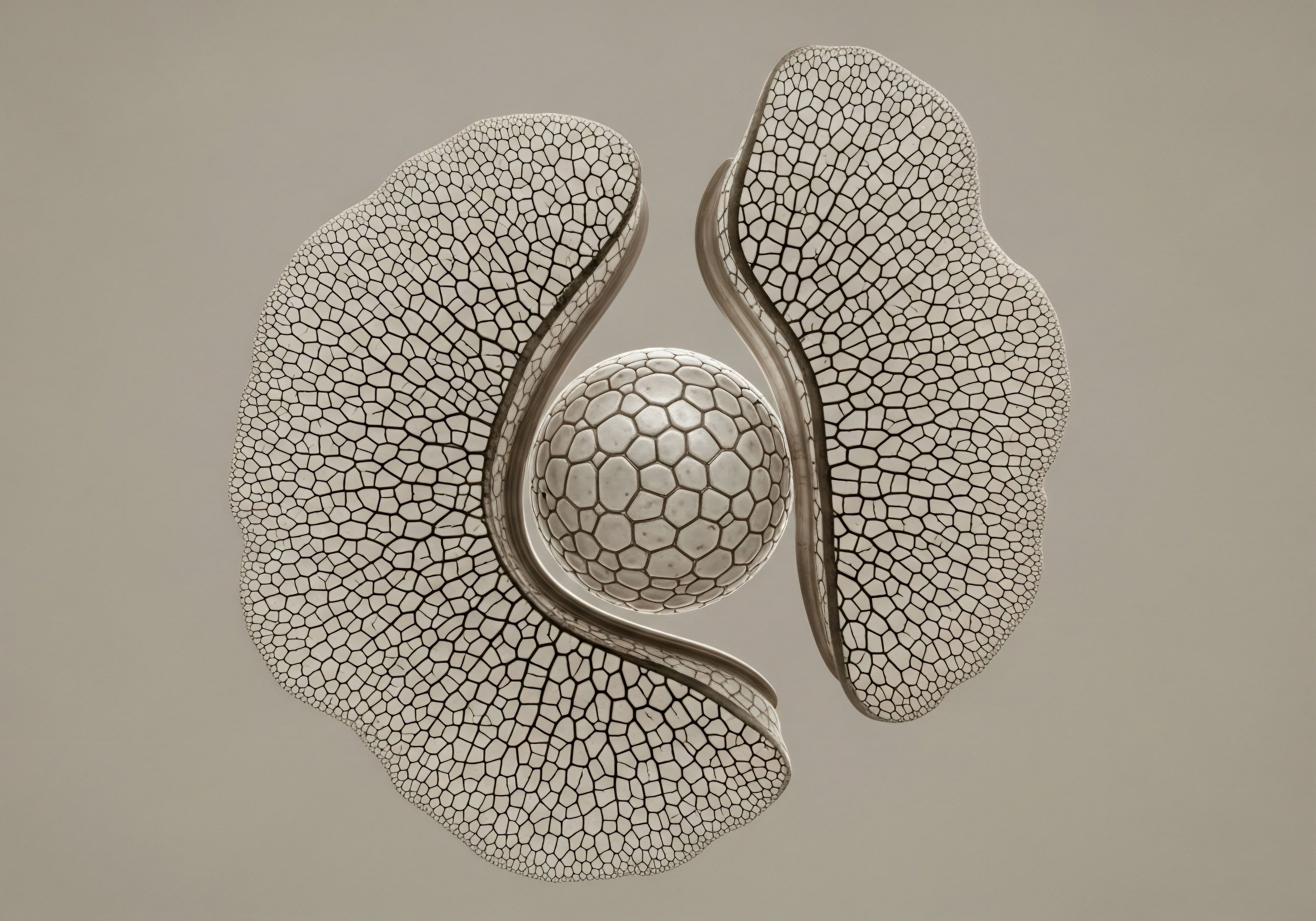

Fundamentals
You feel it before you can name it. A subtle shift in the background hum of your own biology. The energy that once propelled you through demanding days now seems to wane by mid-afternoon. The mental sharpness required for complex problem-solving feels diffused, replaced by a persistent fog.
Perhaps your sense of vitality, the very feeling of being engaged and present in your own life, has become muted. These experiences are not abstract complaints; they are tangible signals from a complex internal communication network, and your endocrine system is the master conductor. When we discuss testosterone optimization, we are initiating a conversation about recalibrating this entire system. The dialogue begins with these feelings of diminished capacity and seeks to understand them through the language of physiology.
Testosterone is a primary signaling molecule within the body, a steroid hormone synthesized from cholesterol that carries essential messages to a vast array of tissues. Its role extends far beyond the development of male sexual characteristics.
Think of it as a key that unlocks specific functions in cells throughout the body, from the brain to the bones to the metabolic machinery within your muscles. Its presence influences how your body builds and maintains lean mass, the density and strength of your skeletal structure, and the production of red blood cells, which are critical for oxygen transport and energy.
When levels of this hormone decline, as they naturally do with age or due to specific health conditions, the messages it carries are delivered with less frequency and intensity. The result is a cascade of systemic effects that you perceive as symptoms.
Declining testosterone levels manifest as a systemic loss of function, affecting everything from cognitive clarity to the body’s ability to manage energy and maintain its structural integrity.
The fatigue you experience is not a simple lack of sleep; it can be a direct consequence of reduced mitochondrial efficiency and a lower red blood cell count, both of which are influenced by testosterone. The difficulty in maintaining muscle mass, even with consistent effort in the gym, points to a shift in the body’s anabolic signals.
The changes in mood and cognitive function, that sense of being less resilient or sharp, are tied to testosterone’s role in modulating neurotransmitter activity and protecting neural pathways in the brain. Understanding this connection is the first step in moving from a state of passive endurance to one of active, informed self-management. It is about recognizing that your subjective experience of well-being is deeply rooted in your objective biological reality.

The Systemic Role of Hormonal Messengers
To truly grasp the impact of testosterone, we must view the body as an interconnected system. Hormones do not operate in isolation. They are part of a sophisticated feedback loop known as the Hypothalamic-Pituitary-Gonadal (HPG) axis.
The hypothalamus in the brain releases Gonadotropin-Releasing Hormone (GnRH), which signals the pituitary gland to release Luteinizing Hormone (LH) and Follicle-Stimulating Hormone (FSH). LH, in turn, travels to the testes in men (or ovaries in women) and stimulates the production and release of testosterone.
The body then monitors circulating testosterone levels, and when they are sufficient, it signals the hypothalamus and pituitary to slow down GnRH and LH production, creating a self-regulating circuit. A disruption at any point in this axis can lead to a deficiency. This is why a comprehensive approach involves assessing the entire system, to understand if the issue originates in the brain’s signaling or in the gonads’ production capacity.

What Happens When the Signal Fades?
A decline in testosterone initiates a series of physiological changes that ripple through the body. These are often gradual and can be mistaken for the unavoidable consequences of aging, yet they represent specific biological shifts that can be addressed. You may notice an increase in body fat, particularly visceral fat around the abdomen, coupled with a decrease in muscle mass.
This change in body composition is a hallmark of altered metabolic signaling. Bones may lose density over time, becoming more susceptible to fractures. Beyond the physical, the cognitive and emotional effects are profound. A diminished sense of well-being, feelings of low motivation, or even a depressive state can be linked directly to insufficient testosterone activity in the brain. Recognizing these symptoms as interconnected aspects of a single underlying issue is the foundational insight for seeking a solution.


Intermediate
Moving from the foundational understanding of testosterone’s systemic role, we now examine the clinical architecture of hormonal optimization protocols. These are structured, data-driven interventions designed to restore testosterone to a physiologically optimal range, thereby addressing the symptoms of deficiency. The process begins with a comprehensive diagnostic phase.
This involves detailed blood analysis to measure not just total testosterone, but also free testosterone (the unbound, biologically active portion), sex hormone-binding globulin (SHBG), estradiol (an estrogen metabolite), LH, and FSH. This complete panel provides a high-resolution image of the HPG axis’s function, allowing a clinician to pinpoint the nature of the hormonal imbalance.
The standard protocol for male testosterone replacement therapy (TRT) often involves weekly intramuscular or subcutaneous injections of Testosterone Cypionate. This esterified form of testosterone provides a stable release profile, preventing the wide fluctuations in hormone levels that can occur with other delivery methods.
A typical starting dose might be 100-200mg per week, but this is always adjusted based on follow-up lab work and the patient’s symptomatic response. The goal is to achieve a trough level (the lowest point, just before the next injection) that places the patient in the upper quartile of the normal reference range for a healthy young adult male.

Balancing the Endocrine Orchestra
A sophisticated TRT protocol does more than just add testosterone. It actively manages the downstream effects to maintain systemic equilibrium. Two critical adjunctive medications are often included:
- Gonadorelin ∞ This is a synthetic analog of GnRH. Its purpose is to mimic the natural pulsatile signal from the hypothalamus to the pituitary gland. By administering small doses of Gonadorelin subcutaneously, typically twice a week, the protocol maintains the stimulation of the testes. This helps preserve testicular size and function, and importantly, supports the body’s endogenous testosterone production pathways.
- Anastrozole ∞ As testosterone levels rise, a portion of it is naturally converted into estradiol via the aromatase enzyme. While some estrogen is necessary for male health (including bone density and libido), excessive levels can lead to side effects like water retention, gynecomastia (breast tissue development), and moodiness. Anastrozole is an aromatase inhibitor, an oral medication usually taken twice a week, that blocks this conversion process, allowing for precise control over estradiol levels.
For some individuals, particularly those concerned with preserving fertility or who have a specific type of hypogonadism, Enclomiphene may be added. This selective estrogen receptor modulator (SERM) works at the pituitary gland to block estrogen’s negative feedback, thereby increasing the output of LH and FSH and stimulating the testes to produce more of their own testosterone.
Effective testosterone optimization involves a multi-faceted approach, using adjunctive therapies to manage the body’s complex hormonal feedback loops and mitigate potential side effects.

Protocols for Female Hormonal Health
Hormonal optimization in women presents its own set of considerations, often focused on alleviating symptoms associated with perimenopause and post-menopause. While estrogen and progesterone are the primary hormones addressed, low-dose testosterone therapy is increasingly recognized for its benefits in improving libido, energy, mood, and cognitive function in women. Protocols are highly individualized:
Testosterone Cypionate may be prescribed in much smaller doses than for men, typically 10-20 units (0.1-0.2ml of a 200mg/ml solution) weekly via subcutaneous injection. Progesterone is also a key component, prescribed based on menopausal status to protect the uterine lining and provide calming, pro-sleep benefits. For some, long-acting testosterone pellets implanted under the skin offer a convenient alternative, sometimes paired with Anastrozole if aromatization is a concern.
| Medication | Primary Function | Typical Administration |
|---|---|---|
| Testosterone Cypionate | Primary androgen replacement | Weekly intramuscular/subcutaneous injection |
| Gonadorelin | Maintains testicular stimulation and function | Twice-weekly subcutaneous injection |
| Anastrozole | Controls conversion of testosterone to estrogen | Twice-weekly oral tablet |
| Enclomiphene | Stimulates natural LH/FSH production | Oral tablet (as prescribed) |

What Are the Implications of Growth Hormone Peptide Therapy?
Beyond direct hormone replacement, advanced protocols may incorporate peptide therapies to optimize the Growth Hormone (GH) axis. Peptides are short chains of amino acids that act as precise signaling molecules. Therapies using Sermorelin, Ipamorelin, or a combination like CJC-1295/Ipamorelin are designed to stimulate the pituitary gland to produce and release the body’s own growth hormone.
CJC-1295 is a long-acting Growth Hormone-Releasing Hormone (GHRH) analog, providing a steady stimulus, while Ipamorelin is a ghrelin mimetic that induces a more immediate pulse of GH release. This approach is often sought by adults looking for benefits in body composition (increased muscle, decreased fat), improved sleep quality, enhanced recovery, and overall vitality. These peptides work synergistically to create a more robust and natural pattern of GH release compared to administering synthetic HGH directly.


Academic
A sophisticated analysis of testosterone’s role beyond sexual function requires a deep exploration of its interaction with metabolic and cardiovascular systems at a molecular level. The strong epidemiological association between low testosterone and metabolic syndrome is well-documented. Men with type 2 diabetes and metabolic syndrome have a significantly higher prevalence of hypogonadism.
This relationship appears to be bidirectional; obesity, particularly visceral adiposity, promotes the aromatization of testosterone to estradiol and suppresses the HPG axis, while low testosterone itself facilitates the accumulation of fat mass and impairs insulin sensitivity. This creates a self-perpetuating cycle of metabolic dysregulation and endocrine dysfunction.
Testosterone exerts direct, beneficial effects on glucose homeostasis and lipid metabolism. At the cellular level, it promotes glucose uptake in skeletal muscle, a primary site of insulin-mediated glucose disposal. It enhances glycolysis and mitochondrial oxidative phosphorylation, the very engines of cellular energy production.
Furthermore, testosterone influences the differentiation of mesenchymal stem cells, promoting a commitment to the myogenic (muscle-building) lineage while inhibiting the adipogenic (fat-storing) lineage. This action is critical for maintaining favorable body composition and insulin sensitivity. Testosterone replacement therapy in hypogonadal men has been shown to improve insulin resistance and glycemic control, reduce visceral fat, and improve lipid profiles by lowering total cholesterol and LDL cholesterol.

Cardiovascular Implications and the TRAVERSE Trial
The historical debate surrounding TRT and cardiovascular risk has been largely reshaped by recent, high-quality evidence. Early observational studies and one prematurely halted trial (the TOM trial) created concern by suggesting a possible increase in cardiovascular events. These studies, however, were often criticized for methodological limitations.
The definitive data point in this discussion is now the TRAVERSE (Testosterone Replacement Therapy for Assessment of Long-Term Vascular Events and Efficacy Response in Hypogonadal Men) trial, a large-scale, randomized, placebo-controlled study published in 2023.
The TRAVERSE trial enrolled over 5,200 men aged 45 to 80 with symptomatic hypogonadism and pre-existing cardiovascular disease. The primary endpoint was a composite of major adverse cardiovascular events (MACE), including cardiovascular death, non-fatal myocardial infarction, and non-fatal stroke. The results demonstrated that testosterone replacement therapy was non-inferior to placebo; it did not increase the risk of MACE.
This landmark finding provides a high degree of reassurance regarding the cardiovascular safety of TRT when used appropriately in a properly diagnosed population. While the study did note a small increased incidence of atrial fibrillation, it definitively refuted the notion that TRT precipitates heart attacks or strokes.
The TRAVERSE trial provided robust, large-scale evidence confirming that testosterone therapy does not increase the risk of major adverse cardiovascular events in men with hypogonadism and prior cardiovascular disease.
| System | Observed Effect of Optimal Testosterone Levels | Underlying Mechanism |
|---|---|---|
| Glucose Metabolism | Improved insulin sensitivity | Increased glucose uptake in muscle; enhanced mitochondrial function. |
| Lipid Metabolism | Reduced total and LDL cholesterol | Modulation of hepatic lipid synthesis and clearance. |
| Body Composition | Increased lean mass, decreased visceral fat | Promotes myogenic and inhibits adipogenic stem cell differentiation. |
| Vascular Health | Potential for slowed atherosclerosis | Anti-inflammatory effects; improved endothelial function. |

How Does Testosterone Affect Cognitive Architecture?
The influence of testosterone on the central nervous system is a critical component of its non-sexual effects. Androgen receptors are widely distributed throughout the brain, particularly in areas associated with memory, attention, and emotional regulation, such as the hippocampus and amygdala.
Low testosterone levels are consistently associated with a higher incidence of depressive symptoms, fatigue, and irritability. Studies have demonstrated that men with lower testosterone may exhibit poorer performance on tasks related to verbal and spatial memory. Testosterone replacement therapy in hypogonadal men can lead to measurable improvements in mood, reducing negative feelings and increasing a sense of vigor and well-being.
It has also been shown to improve or stabilize certain aspects of cognitive function, suggesting a neuroprotective role. The hormone appears to modulate key neurotransmitter systems, including dopamine and serotonin, which are fundamental to mood and motivation. This biochemical recalibration within the brain is what translates to the subjective experience of enhanced mental clarity and emotional resilience.

References
- Basaria, S. Coviello, A. D. Travison, T. G. Storer, T. W. Farwell, W. R. Jette, A. M. & Bhasin, S. (2010). Adverse events associated with testosterone administration. New England Journal of Medicine, 363(2), 109-122.
- Jones, T. H. Arver, S. Behre, H. M. Buvat, J. Meuleman, E. Moncada, I. & Zitzmann, M. (2011). Testosterone replacement in hypogonadal men with type 2 diabetes and/or metabolic syndrome (the TIMES2 study). Diabetes care, 34(4), 828-837.
- Lincoff, A. M. Bhasin, S. Flevaris, P. Mitchell, L. M. Basaria, S. Boden, W. E. & TRAVERSE Study Investigators. (2023). Testosterone replacement therapy and cardiovascular outcomes. New England Journal of Medicine, 389(2), 107-117.
- Traish, A. M. (2014). Testosterone and weight loss ∞ the evidence. Current opinion in endocrinology, diabetes, and obesity, 21(5), 313.
- Zitzmann, M. (2009). Testosterone deficiency, insulin resistance and the metabolic syndrome. Nature Reviews Endocrinology, 5(12), 673-681.
- Saad, F. Aversa, A. Isidori, A. M. & Gooren, L. J. (2011). Testosterone as potential effective therapy in treatment of obesity in men with testosterone deficiency ∞ a review. Current diabetes reviews, 7(6), 403-411.
- Hollander, W. & Prusty, S. (1997). The effects of testosterone on the heart and the cardiovascular system. Current Opinion in Cardiology, 12(4), 389-396.
- Teichman, S. L. Neale, A. Lawrence, B. Gagnon, C. Castaigne, J. P. & Frohman, L. A. (2006). Prolonged stimulation of growth hormone (GH) and insulin-like growth factor I secretion by CJC-1295, a long-acting analog of GH-releasing hormone, in healthy adults. The Journal of Clinical Endocrinology & Metabolism, 91(3), 799-805.
- Salas-Huetos, A. Rosique-Esteban, N. Becerra-Tomás, N. Vizmanos, B. Bulló, M. & Salas-Salvadó, J. (2018). The effect of testosterone replacement therapy on psychosocial and sexual well-being and cognitive function ∞ a systematic review and meta-analysis of randomized controlled trials. The Journal of Clinical Endocrinology & Metabolism, 103(12), 4448-4458.
- Hackett, G. Kirby, M. & Sinclair, A. J. (2014). Testosterone deficiency, cardiac disease and mortality in men. The aging male, 17(3), 154-160.

Reflection
The information presented here forms a map, detailing the intricate connections between a single signaling molecule and the broad experience of your own vitality. It translates the subjective feelings of fatigue or mental fog into the objective language of cellular biology and endocrine pathways. This knowledge is the starting point.
Your personal physiology is a unique landscape, shaped by genetics, lifestyle, and your individual history. Understanding the principles of hormonal optimization is the first and most critical step, but applying them requires a personalized approach. Consider where your own experiences align with the systems described. Reflect on the symptoms that most impact your daily function. This internal audit, guided by a new understanding of the underlying mechanisms, is the beginning of a proactive and empowered partnership with your own health.

Glossary

testosterone optimization

cognitive function

pituitary gland

testosterone levels

body composition

hpg axis

testosterone replacement therapy

gonadorelin

anastrozole

hypogonadism

growth hormone

ipamorelin

cjc-1295

metabolic syndrome

testosterone replacement

insulin resistance

major adverse cardiovascular events

the traverse trial




